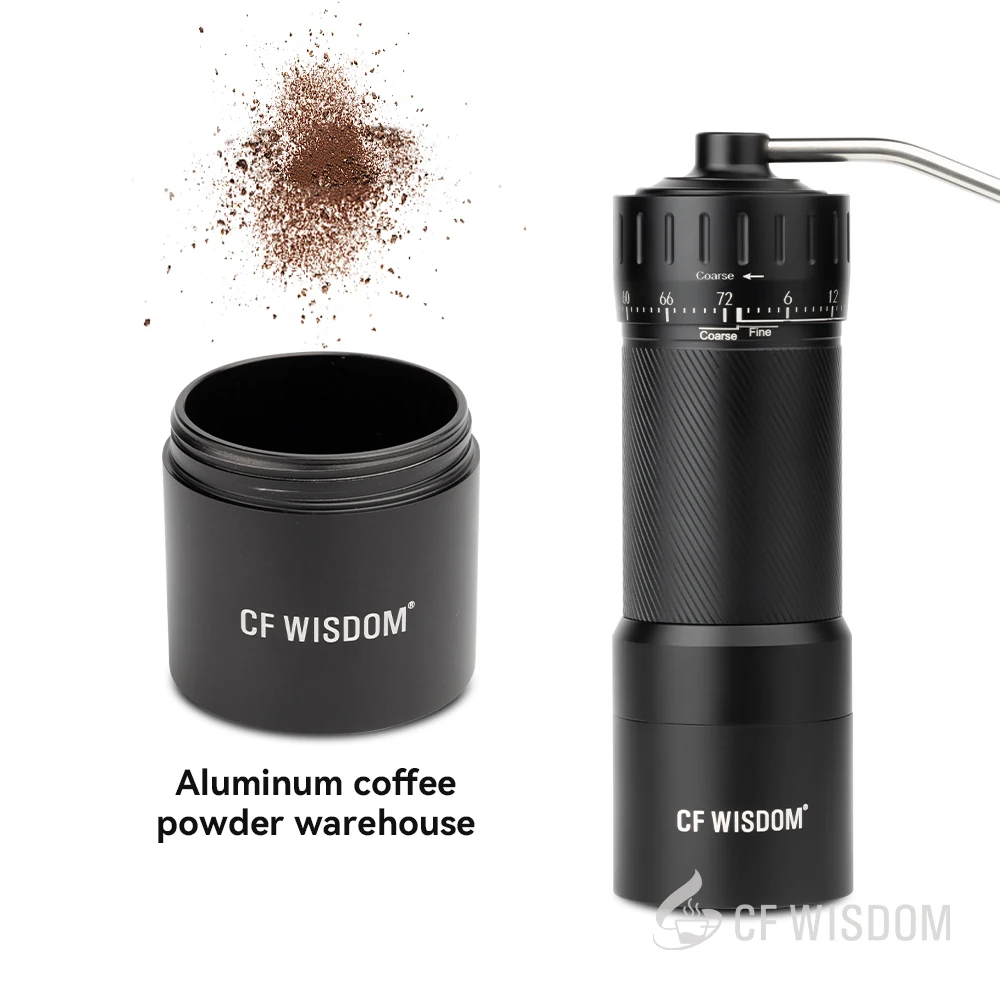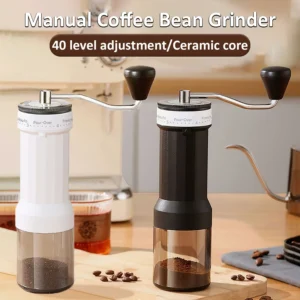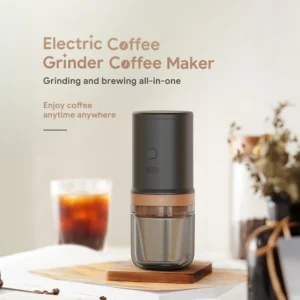Why Quality Coffee Grinding Matters for Travel
Coffee enthusiasts know a fundamental truth: the freshest cup comes from freshly ground beans. When traveling, this principle becomes even more important as many settle for subpar coffee options on the road.
What many don’t realize is that coffee beans begin losing their precious aromatic compounds immediately after grinding. In fact, a staggering 80% of coffee’s complex aroma dissipates within just 15 minutes of grinding. This rapid deterioration happens because grinding increases the surface area exposed to oxygen, triggering oxidation processes that break down the volatile compounds responsible for coffee’s distinctive flavors.
The difference between properly ground coffee and pre-ground options significantly impacts your brewing experience:
- Freshly ground coffee preserves essential oils and aromatic compounds that create depth of flavor
- Consistent grind particles ensure even extraction, preventing bitter over-extraction or weak under-extraction
- Proper grinding allows you to adjust for different brewing methods and water conditions while traveling
- The ability to grind at the moment of brewing means experiencing coffee as it was meant to be tasted
When you travel with whole beans and a quality grinder, you essentially carry a mini coffee shop in your luggage. Understanding the precision grind settings for optimal flavor extraction becomes your ticket to exceptional coffee anywhere in the world.
Key Factors to Consider When Choosing a Travel Coffee Grinder
Selecting the perfect travel coffee grinder requires balancing several critical factors that will directly impact your brewing experience on the road:
Portability Metrics: Weight is paramount for travelers, with the best options ranging from 8-12 ounces (227-340g). Consider not just overall dimensions but also form factor—slim cylindrical grinders slip into cup holders and water bottle pockets, while wider models may offer more stability. Collapsible handles can reduce packed size by 2-3 inches (5-7.5cm).
Grind Consistency: Perhaps the most crucial technical aspect of any grinder. Different brewing methods demand specific grind sizes—coarse for French press (like sea salt), medium for pour-over (like regular sand), and fine for AeroPress or espresso (like table salt or finer). A quality travel grinder must maintain consistency across these settings.
Build Materials: Travel conditions can be harsh. Grinders constructed from aircraft-grade aluminum, stainless steel, or high-impact polymers offer the best durability. Metal components generally outperform plastic for long-term reliability in challenging environments.
Capacity Considerations: Most travel grinders hold 20-30 grams of beans—enough for 1-2 cups of coffee. Assess your typical brewing quantity needs before selecting a model that might prove too limited or unnecessarily large.
Adjustment and Maintenance: The ability to easily adjust grind settings and clean your grinder on the go is essential. Look for tool-free disassembly and simple cleaning methods that don’t require running water (which might be limited while traveling).
The travel coffee grinder collection available today represents significant advancements in portability without sacrificing performance. The right choice depends largely on your specific travel style and coffee preferences.
Manual vs. Electric Travel Grinders: Pros and Cons
When choosing between manual and electric travel grinders, understanding their fundamental differences helps match your selection to your travel style:
| Feature | Manual Grinders | Electric Grinders |
|---|---|---|
| Power Source | Human effort | Battery/outlet dependent |
| Weight | 8-12 oz (227-340g) typically | 12-24 oz (340-680g) typically |
| Grind Consistency | Excellent (premium models) | Variable (depending on model) |
| Durability | High (fewer moving parts) | Moderate (more complex mechanics) |
| Noise Level | Low-moderate | Moderate-high |
| Grinding Time | 60-90 seconds per 20g | 20-30 seconds per 20g |
| Travel Practicality | Very high | Moderate |
Manual grinders dominate the travel market for good reason. Their independence from power sources makes them ideal for backpacking, camping, and international travel where outlets may be scarce or incompatible. The simplicity of their mechanisms means fewer potential failure points in challenging conditions.
Electric grinders offer speed and convenience but come with significant tradeoffs for travelers. Battery life becomes another element to manage, and the additional weight and bulk can be prohibitive for lightweight packers. However, they may be worth considering for:
- Road trips or car camping where weight is less concerning
- Travelers with physical limitations that make manual grinding difficult
- Situations where you’re preparing coffee for larger groups
Most serious coffee enthusiasts find that high-quality portable coffee grinders of the manual variety strike the optimal balance between performance and practicality for travel scenarios.
Comprehensive Travel Coffee Grinder Comparison Table
| Model Type | Weight | Packed Dimensions | Capacity | Burr Material | Adjustment | Price Range | Notable Features | Best For |
|---|---|---|---|---|---|---|---|---|
| Premium Manual | 11 oz (312g) | 6.1 × 2.0 in (15.5 × 5.1 cm) | 25g | Stainless steel | Stepped, 15 settings | $$$$ | Magnetic catch cup, travel case | Pour-over, AeroPress |
| Mid-range Manual | 12 oz (340g) | 7.0 × 2.3 in (17.8 × 5.8 cm) | 30g | Ceramic | Stepped, 12 settings | $$$ | Foldable handle, rubber grip | All methods |
| Budget Manual | 9.5 oz (269g) | 6.5 × 1.8 in (16.5 × 4.6 cm) | 20g | Stainless steel | Stepped, 6 settings | $$ | Silicone grip, compact design | Drip, pour-over |
| Ultralight Manual | 8 oz (227g) | 5.9 × 1.5 in (15 × 3.8 cm) | 18g | Ceramic | Continuous adjustment | $$$ | Minimalist design, protective sleeve | Backpacking |
| Electric Compact | 18 oz (510g) | 4.5 × 2.6 in (11.4 × 6.6 cm) | 25g | Stainless steel | Digital, 15 settings | $$$$ | USB rechargeable, timer function | Car camping, hotels |
This comparison highlights the significant variance in features across the travel grinder spectrum. Weight differences of just a few ounces can make a substantial difference in packability, while capacity variations determine how many servings you can prepare in one grinding session.
The adjustment mechanism dramatically affects brewing versatility—models with more grind settings or continuous adjustment allow precise tuning for specific brewing methods. Understanding these specifications in relation to your preferred espresso grind size or other brewing methods is essential for selecting the right travel companion.
Top Manual Travel Coffee Grinders Reviewed
Premium Compact Option: The Summit Pro
The Summit Pro represents the pinnacle of portable grinding technology. Machined from aircraft-grade aluminum with stainless steel burrs, this grinder feels like a precision instrument in your hand.
Design and Build: At 11 ounces (312g), the Summit Pro strikes an ideal balance between durability and portability. The magnetic catch cup attaches firmly yet detaches easily for brewing. The textured aluminum body provides excellent grip even with wet hands—a thoughtful feature for outdoor brewing scenarios.
Grind Performance: The 38mm conical burrs deliver exceptional consistency across all grind settings. Testing revealed minimal fines (coffee dust) even at coarser settings, a common issue with lesser grinders. A full load of beans (25g) requires approximately 65 seconds of grinding effort.
Travel Features: The collapsible handle reduces packed height by 2 inches (5cm), while the included neoprene case provides protection in crowded backpacks. The tool-free disassembly makes cleaning practical even without running water.
Real-world Performance: The Summit Pro maintained consistent performance during a two-week backpacking trip, including in humid conditions that would challenge lesser equipment.
Pros:
– Exceptional grind consistency rivals home grinders
– Durable construction withstands travel abuse
– Smooth, efficient grinding action reduces effort
Cons:
– Premium price point
– Slightly heavier than ultralight options
– Limited capacity for group brewing
Mid-range Balanced Option: The Alpine Grind
The Alpine Grind offers impressive performance at a more accessible price point, making it a favorite among value-conscious travelers.
Design and Build: With a stainless steel body and reinforced plastic components, this 12-ounce (340g) grinder balances durability with cost considerations. The foldable handle feels secure in use and significantly reduces packed size.
Grind Performance: The ceramic burrs provide good consistency across medium to coarse settings, though they produce more fines at the espresso end than premium models. Grinding 20g of beans takes approximately 75-90 seconds depending on setting.
Travel Features: The grippy silicone base prevents slipping during use, while the clear bean hopper lets you monitor grinding progress. At 7 inches tall when packed, it fits in most camp cooking kits.
Real-world Performance: The Alpine performed admirably during hotel stays and car camping, though the grinding action becomes slightly less smooth after extensive use.
Pros:
– Excellent value for money
– Versatile grind range suits most brewing methods
– Comfortable ergonomics for daily use
Cons:
– Requires more maintenance to keep grinding smooth
– Slightly longer grinding time than premium options
– Less refined construction than top-tier models
Fine Adjustment Hand Grinder, Precision Manual Grinder, Travel Coffee Grinder
Price range: $185.11 through $494.63 Select options This product has multiple variants. The options may be chosen on the product pageHand Burr Grinder, Hand Crank Coffee Grinder, Manual Espresso Grinder, Portable Coffee Grinder
Price range: $262.72 through $300.22 Select options This product has multiple variants. The options may be chosen on the product pageCeramic Burr Coffee Grinder, Hand Burr Grinder, Hand Crank Coffee Grinder, Manual Coffee Bean Grinder
Price range: $59.17 through $59.96 Select options This product has multiple variants. The options may be chosen on the product pageHandheld Burr Grinder, Manual Coffee Mill Grinder, Travel Coffee Grinder
$191.45 Select options This product has multiple variants. The options may be chosen on the product page
Additional models worth consideration include the ultralight Trailmaster at just 8 ounces (227g) for weight-conscious backpackers and the budget-friendly Nomad Basic that delivers acceptable performance at half the price of premium options. Serious coffee enthusiasts should explore our collection of handheld coffee grinders for more specialized options.
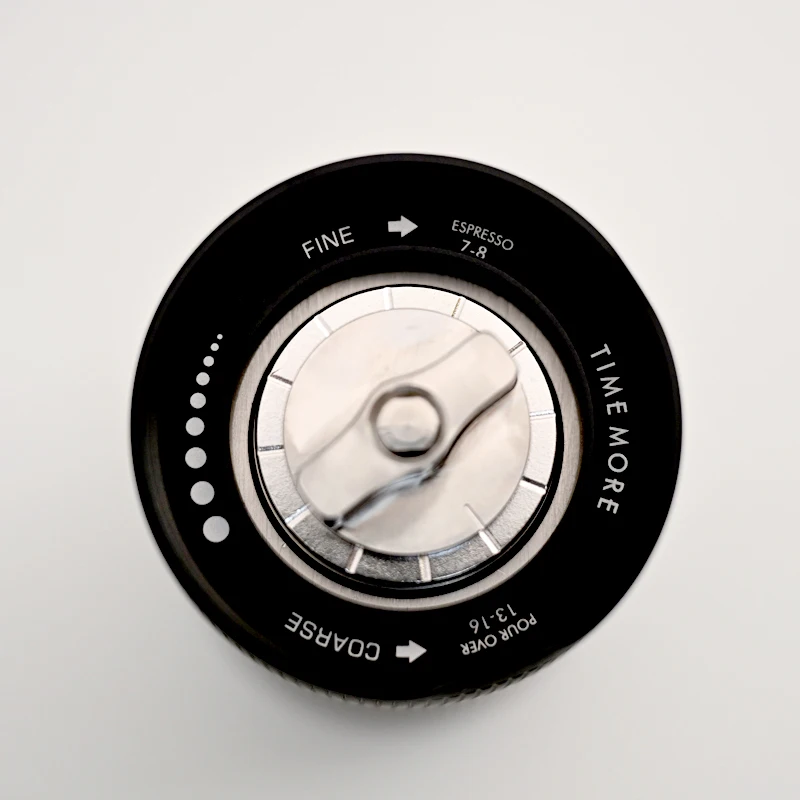
Best Electric Travel Coffee Grinder Options
While manual grinders dominate the travel coffee scene, a few electric options have emerged that genuinely work for certain travel scenarios. The key question is whether the convenience outweighs the additional weight and power dependencies.
The PowerGrind Traveler stands out as the most viable electric option. At 18 ounces (510g), it’s approximately twice the weight of ultralight manual alternatives but offers impressive performance:
- USB-C rechargeable battery provides enough power for 8-10 grinding sessions
- Surprisingly consistent grind quality comparable to mid-range manual grinders
- One-button operation with preset timer functions for consistent dose amounts
- Relatively quiet operation (70db) compared to standard electric grinders (85db+)
The VoyageElectric model offers a smaller footprint at the expense of capacity, grinding only 15g at a time—sufficient for a single cup. Its primary advantage is speed, completing a grind cycle in about 25 seconds.
Pros of electric travel grinders:
– No physical effort required to grind
– Faster operation, especially for multiple cups
– More consistent results for users who struggle with manual grinding technique
Cons of electric travel grinders:
– Dependent on battery life or power access
– Nearly double the weight of manual alternatives
– Higher mechanical complexity means more potential failure points
– Typically louder operation, problematic in shared accommodations
Understanding the differences between manual and automatic grinding approaches will help determine if the convenience benefits outweigh the practical disadvantages for your particular travel style.
Burr Types Explained: Ceramic vs. Steel for Travelers
The heart of any quality coffee grinder is its burr set—the mechanism that actually crushes and cuts the beans to your desired size. For travelers, the choice between ceramic and steel burrs involves important tradeoffs:
Steel Burrs:
– Superior cutting precision, especially for finer grinds
– Maintain sharpness for 1,000-1,500 pounds (450-680kg) of coffee before dulling
– Slightly heavier than ceramic counterparts
– Conduct heat more readily, potentially affecting flavor during extended grinding
– Resist damage from impacts and drops better than ceramic
Ceramic Burrs:
– Excellent heat resistance prevents flavor changes during grinding
– Stay sharp longer, typically handling 1,500-2,000 pounds (680-907kg) of coffee
– Lighter weight, beneficial for ultralight travel setups
– More brittle and susceptible to damage if dropped
– Perform well in humid conditions without corrosion concerns
The practical differences manifest in various travel scenarios. Steel burrs make more sense for travelers who frequently cross borders or check luggage, as their durability withstands rougher handling. Ceramic burrs suit travelers in humid tropical environments where corrosion resistance matters more.
For grind quality, both can deliver excellent results when well-designed. Steel burrs typically excel at espresso-fine grinds, while ceramic burrs often produce more consistent medium and coarse grinds ideal for pour-over and French press brewing.
Our ceramic burr coffee grinder collection offers excellent options for travelers seeking the perfect balance between heat resistance and grind quality.
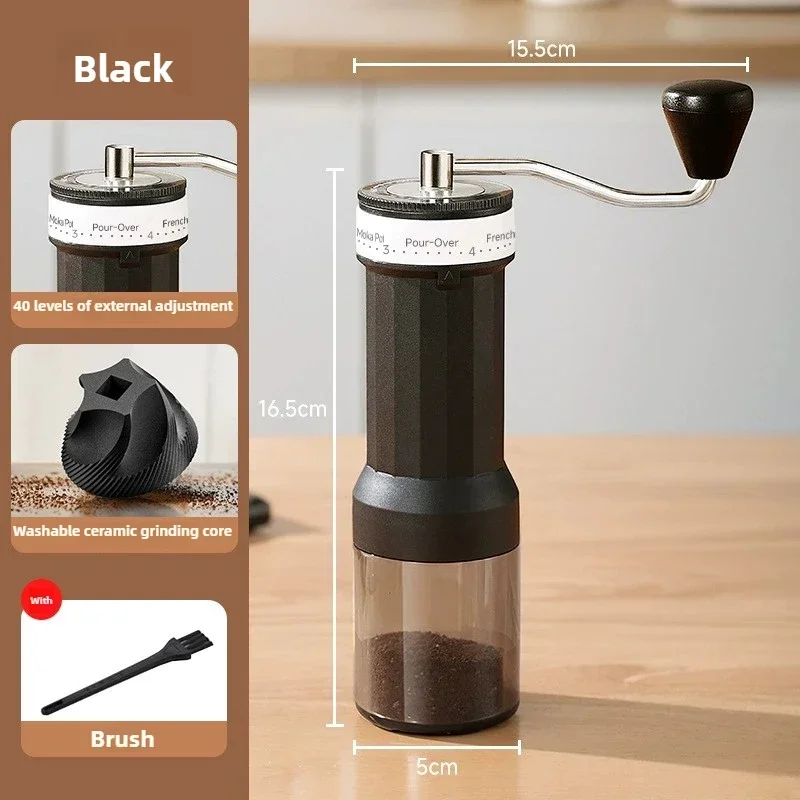
How to Test Grind Consistency While Traveling
Evaluating your grinder’s performance during travel doesn’t require laboratory equipment. These simple techniques help assess grind consistency anywhere:
Visual Inspection Method:
1. Grind a small amount of coffee (10g) on a medium setting
2. Place the grounds on a dark, non-patterned surface (like a black notebook)
3. Spread them thinly with a card or knife edge
4. Look for obvious particle size variations under good lighting
5. High-quality grinds should appear remarkably uniform with minimal dust or chunks
The Paper Towel Test:
1. Place a pinch of ground coffee on a white paper towel
2. Gently fold the towel over and press down
3. Unfold and observe the residue pattern
4. Consistent grinds leave even coloration; poor consistency shows dark spots (fines) and light areas
The Glass of Water Test:
1. Place a small amount of ground coffee in clear water
2. Observe how particles settle—fines float longer while larger particles sink quickly
3. Greater separation indicates inconsistent grinding
Taste Assessment:
Even taste can reveal grind quality issues. Excessive bitterness often indicates too many fines causing over-extraction, while sourness can signal inconsistent larger particles causing under-extraction.
If performance degrades during your travels, basic maintenance like cleaning the burrs or realigning components can often resolve issues. Understanding how burr size affects grind consistency provides valuable context for troubleshooting grinder performance.
Cleaning and Maintaining Your Travel Coffee Grinder
Proper maintenance ensures your travel coffee grinder delivers consistent performance throughout your journey. Follow these travel-friendly cleaning methods:
Daily Quick Cleaning:
1. Tap the disassembled grinder gently to remove loose grounds
2. Use a small brush (a clean makeup brush or paintbrush works well) to sweep out remaining particles
3. Wipe down exterior surfaces with a dry cloth
Weekly Deep Cleaning:
1. Fully disassemble the grinder according to manufacturer instructions
2. Use a dry toothbrush to clean burrs thoroughly, focusing on crevices
3. For stubborn coffee oils, use uncooked rice or grinder cleaning tablets:
– Run a small amount of either through the grinder
– Follow with a small amount of coffee beans to remove any residue
4. Blow out remaining dust with a camera lens blower or clean breath
Storage During Transit:
1. Ensure the grinder is completely dry before storing
2. Keep the adjustment at a medium setting to reduce stress on components
3. If space allows, pack the grinder with soft clothing items for protection
4. For aluminum grinders, prevent scratches by using the provided case or a soft pouch
Material-Specific Maintenance:
– Aluminum bodies: Avoid contact with saltwater; rinse and dry thoroughly if exposed
– Stainless steel: Periodically check for rust spots in high-humidity environments
– Ceramic burrs: Handle with extra care during cleaning to prevent chips or cracks
Follow these practices, and your grinder should maintain optimal performance throughout years of travel adventures. For more thorough information on cleaning techniques, our guide on proper cleaning of manual coffee grinders provides additional details.
Size and Weight Comparison: Finding the Most Portable Options
For travelers, every ounce and cubic inch matters. Here’s how popular travel grinders compare:
| Grinder Model | Weight | Packed Dimensions | Volume | Form Factor | Best For |
|---|---|---|---|---|---|
| UltraLite Mini | 7.8 oz (221g) | 5.2 × 1.8 in (13.2 × 4.6 cm) | 13.2 cu in | Slim cylinder | Ultralight backpacking |
| TrailMaster Pro | 9.1 oz (258g) | 6.0 × 2.0 in (15.2 × 5.1 cm) | 18.8 cu in | Cylinder with flip handle | General travel |
| AlpineGrind Plus | 11.6 oz (329g) | 6.8 × 2.3 in (17.3 × 5.8 cm) | 28.2 cu in | Wide cylinder | Car camping, hotels |
| CoffeeBox Mini | 10.2 oz (289g) | 3.5 × 2.4 × 2.4 in (8.9 × 6.1 × 6.1 cm) | 20.1 cu in | Rectangular | Suitcase packing |
| ElectroMill Travel | 17.5 oz (496g) | 4.7 × 2.7 in (11.9 × 6.9 cm) | 27.0 cu in | Squat cylinder | Vehicle travel |
The form factor significantly impacts packability beyond raw dimensions. Cylindrical grinders fit well in water bottle pockets and cup holders but may waste space in rectangular luggage. Rectangular designs pack efficiently in suitcases but might feel awkward to use.
Consider where you’ll store your grinder:
– Backpack side pocket: Slim cylindrical designs work best
– Inside a cooking pot: Shorter, wider models may nest better
– Suitcase: Rectangular or protected designs prevent damage
Additional size considerations include protective cases, which typically add 0.5-1 inch (1.3-2.5 cm) to all dimensions. Some models feature integrated protection, while others require separate cases.
For travelers who count every gram, our compact coffee mill collection features several ultralight options without sacrificing too much functionality.
Brewing Methods and Grind Settings for Travel
Different travel brewing methods require specific grind sizes for optimal extraction. Here’s how to match your grinder settings to common travel brewing equipment:
| Brewing Method | Grind Size | Descriptive Texture | Typical Setting* | Notes |
|---|---|---|---|---|
| AeroPress (standard) | Medium-fine | Table salt | 6-8 | Faster brew time than at home |
| AeroPress (inverted) | Medium | Fine sand | 8-10 | Allows longer steeping |
| Pour-over (V60, Kalita) | Medium | Sand | 10-14 | May need slightly coarser at altitude |
| French Press | Coarse | Sea salt | 18-22 | Requires consistent coarse particles |
| Moka Pot | Fine | Between flour and salt | 4-6 | Slightly coarser than espresso |
| Cold Brew | Extra coarse | Rock salt | 24-30 | Consistency matters less |
| Instant Methods (cowboy coffee) | Medium-coarse | Coarse sand | 16-18 | Allows grounds to settle |
*Setting numbers are approximate and vary by grinder model; use texture as your primary guide.
Travel conditions can affect your optimal grind setting. At higher altitudes, water boils at lower temperatures, potentially requiring a slightly coarser grind to prevent over-extraction. Similarly, very humid environments may affect how coffee extracts, occasionally necessitating grind adjustments.
A practical tip for travelers: take a photo of your grinder’s setting before disassembly for cleaning. This provides a visual reference to help you return to your preferred setting after maintenance.
For AeroPress users specifically, our AeroPress travel grind guide offers detailed recommendations for different recipe variations while traveling.
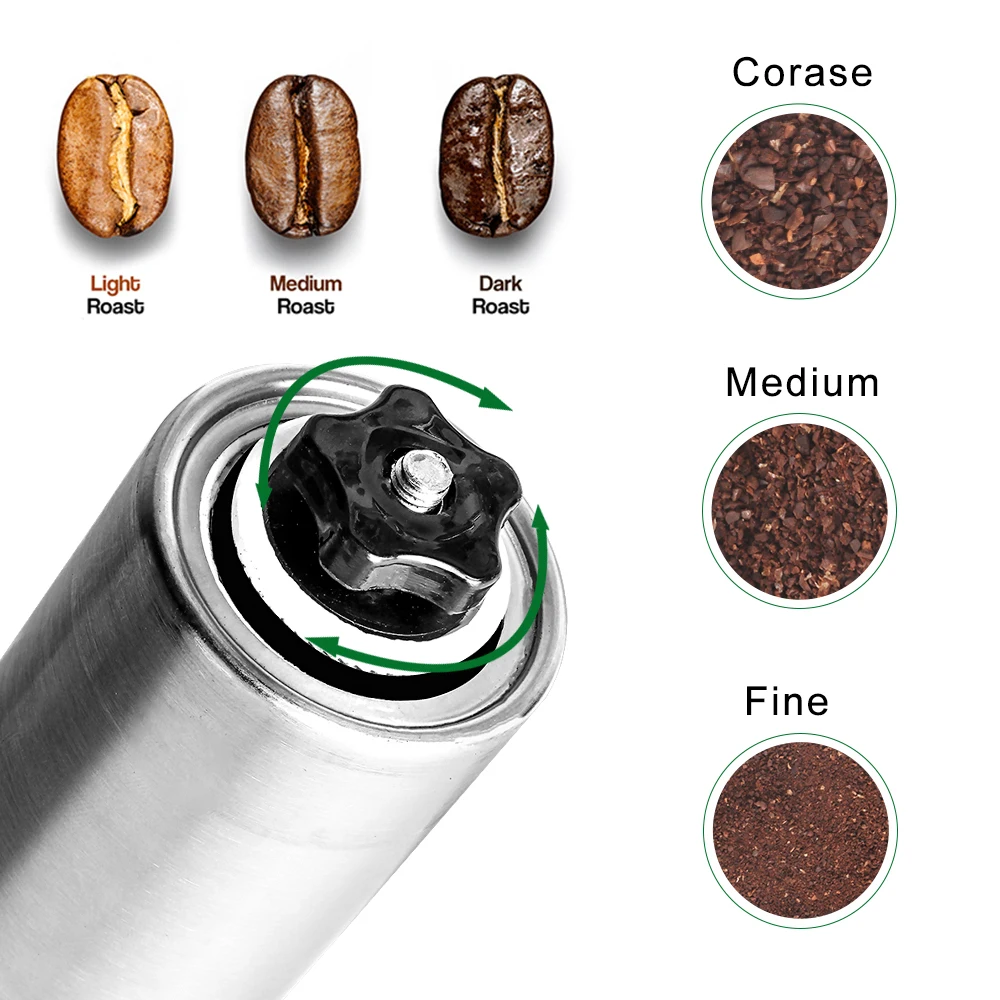
Travel Coffee Grinder Accessories Worth Considering
Enhance your mobile coffee experience with these carefully selected accessories that complement your travel grinder setup:
Protective Cases and Pouches: Neoprene sleeves or hardshell cases add minimal weight (1-2 oz/28-57g) while preventing damage during transit—particularly important for grinders with glass components.
Travel-Size Cleaning Kits: Compact brush sets with small bristle brushes and grinder picks help maintain your equipment on the go without requiring water access.
Dosing Tools: Collapsible coffee scoops that measure exactly 10g save you from carrying a scale and ensure consistent brewing ratios.
Compact Bean Storage: Vacuum-sealed containers with one-way valves preserve bean freshness for up to two weeks—much better than plastic bags. Look for options under 4 oz (113g) that hold 100-150g of beans.
Grinder-to-Brewer Adapters: Direct-connect adapters for AeroPress allow grinding directly into the brewing chamber, reducing messiness and coffee loss during transfer—ideal for cramped brewing conditions.
Stabilizing Bases: Silicone grinder pads provide stability on uneven surfaces like camp tables or hotel nightstands while protecting surfaces from damage.
These accessories integrate seamlessly with all-metal hand grinders to create a complete travel coffee system that delivers exceptional brewing results anywhere your adventures take you.
Are Expensive Travel Coffee Grinders Worth It?
The price range for travel coffee grinders spans from $30 budget options to $250+ premium models—a significant variation that raises questions about value. Here’s what your investment actually buys at different price points:
Entry-Level ($30-60):
– Basic grinding capability with acceptable consistency for less demanding brew methods
– Typically made with more plastic components
– Generally requires 25-50% more time and effort to grind
– Expected lifespan: 1-3 years of regular use
– Best for: occasional travelers, beginners exploring better coffee
Mid-Range ($60-120):
– Good grind consistency suitable for most brewing methods
– Mixed construction with metal bodies and some plastic components
– Smoother operation requiring moderate effort
– Expected lifespan: 3-5 years of regular use
– Best for: regular travelers who brew daily
Premium ($120-250+):
– Excellent grind consistency rivaling home electric grinders
– Full metal construction with precision-machined components
– Efficient grinding mechanism requiring minimal effort
– Expected lifespan: 5-10+ years, often with replaceable parts
– Best for: serious coffee enthusiasts who travel frequently
The value equation shifts based on your usage patterns. For someone who travels weekly and brews twice daily, a premium grinder amortizes to roughly $0.20 per use over five years—a reasonable investment for significantly better coffee. Occasional travelers might find less justification for the higher-end models.
The most noticeable performance differences appear when brewing methods that demand precise grinding, particularly for those seeking perfect espresso grind settings while traveling.
Frequently Asked Questions About Travel Coffee Grinders
Can I take a coffee grinder on an airplane?
Yes, both manual and electric coffee grinders are permitted in carry-on and checked luggage according to TSA guidelines. Manual grinders rarely cause security concerns, but electric models may require additional screening.
How long does it take to grind coffee manually?
For a standard 20g dose (enough for one cup), expect 45-90 seconds of grinding with a high-quality manual grinder. Budget models may require 2-3 minutes for the same amount. Grinding effort decreases significantly with higher-quality burrs.
How long do burrs typically last?
Steel burrs generally remain sharp through 1,000-1,500 pounds (450-680kg) of coffee before noticeable dulling. Ceramic burrs often last 1,500-2,000 pounds (680-907kg). For the average traveler, this translates to 5-10 years of regular use before considering burr replacement.
Are travel grinders suitable for espresso?
Premium travel grinders can achieve the consistency needed for pressurized espresso machines and devices like the Flair or Nanopresso. However, they may struggle with the ultra-fine, perfectly consistent grind required by traditional non-pressurized espresso machines.
Can I use a travel grinder as my everyday home grinder?
Absolutely. Many premium travel grinders perform comparably to entry-level electric home grinders. The main limitation is capacity—grinding for multiple people requires several batches.
How should I pack a coffee grinder to prevent damage?
Ideally, store your grinder inside a protective case or wrap it in clothing within your luggage. Set the burrs to a medium setting during transit to reduce stress on the adjustment mechanism. For maximum protection, remove the handle if your model allows it.
What’s the quietest option for shared accommodations?
Manual grinders operate at approximately 40-60 decibels—similar to moderate conversation. The quietest models use design features like double bearings and rubber dampers to further reduce noise. Electric travel grinders typically generate 65-75 decibels, roughly equivalent to a vacuum cleaner.
For more information about longevity and maintenance, our guide on how long manual coffee grinders last provides detailed insights.
Finding Your Perfect Travel Coffee Companion
After exploring the technical aspects, performance characteristics, and practical considerations of travel coffee grinders, your perfect match depends primarily on your specific travel style and coffee preferences.
For the ultralight backpacker counting every ounce, compact grinders like the UltraLite Mini offer tremendous value despite minor compromises in capacity and adjustment range. At under 8 ounces (227g), these minimalist marvels make excellent companions for multi-day treks where weight savings are paramount.
The coffee perfectionist who refuses to compromise on flavor will find premium models worth their weight and cost. The exceptional grind consistency, precision adjustment, and durable construction ensure café-quality results whether you’re in a five-star hotel or a remote mountain cabin.
Budget-conscious travelers should focus on mid-range models that balance performance and value. These grinders deliver significantly better results than pre-ground coffee without the investment required for premium options. Their simplified construction often means less maintenance complexity as well.
Those prioritizing convenience might consider the new generation of compact electric grinders, provided their travel typically includes reliable access to power for recharging. The time and effort savings can be substantial, especially when preparing coffee for multiple people.
Whichever path you choose, investing in a quality travel coffee grinder fundamentally transforms your travel experiences. The ritual of grinding fresh beans connects you to the moment, while the resulting cup provides comfort and familiarity regardless of your location. The benefits of compact coffee grinders for travel extend beyond mere convenience—they represent self-sufficiency and the ability to create moments of perfect enjoyment anywhere in the world.
At Savor Suite, we believe that great coffee shouldn’t be limited by location. Our carefully curated selection of travel grinders embodies this philosophy, offering solutions for every type of traveler who refuses to compromise on their coffee experience.

